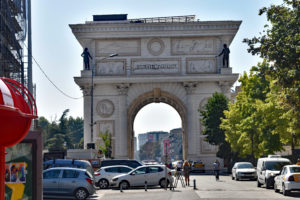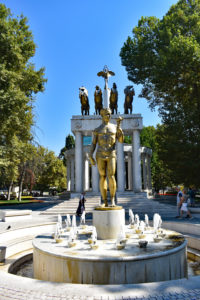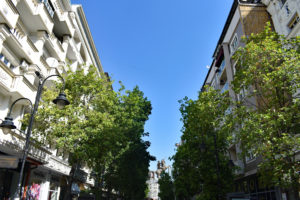We spent three nights in Skopje, the capital of North Macedonia. On the drive there from “Prizren”:https://www.silvertraveladvisor.com/review/attraction/203237-review-sightseeing-in-prizren in Kosovo, our driver Edmond said we’d be amazed at the number of statues, but little did we know exactly how many we’d see.
Skopje 2014 was a project financed by the government with the purpose of giving the capital a more classical appeal. Controversially a figure somewhere between the original estimate of €80m and €500+m was spent on new museums, bridges, monuments and of course, statues. Many we met felt that the money would have been better spent on hospitals, education etc. and the words bribes, embezzlement and other less honest activities were frequently used.
There are two parts to the city: the “old town”:https://www.silvertraveladvisor.com/review/attraction/203391-review-sightseeing-in-skopje-part-1-the-old-town or Čaršija, and the modern town centre. Our “Hotel de KOKA”:https://www.silvertraveladvisor.com/review/accommodation/203347-review-hotel-de-koka was ideally situated between the two. We only needed to look from our bedroom window to see Skanderbeg Square with its statue of Skanderbeg on horseback and a large mural depicting all things Albanian. We spent much of our days flitting between the two, either on a guided tour or under our own steam.
Affecting all areas of the city, was an earthquake in 1963 when 70%+ of the buildings were destroyed, with around 1,000 fatalities.
Both Skopje 2014 and the earthquake have had a major impact on the city and as there was so much to see, I’ve split my review into two: old and new. As I found it impossible to choose just eight photos which reflects the sheer volume of statues, links have been included to photos from the internet.
The modern centre
The River Vardar separates the old town and modern centre. Although it is a deep river, water levels were low, exposing piles of stone dumped as a result of the significant amount of building work. Three half Galleon were moored up in the river having been converted into bars/restaurants, but all appeared closed during our visit.
There are a number of bridges crossing the river with three new pedestrian ones created as part of Skopje 2014. Our guide described the first as the London Eye Bridge. The original intention had been to build a huge Ferris wheel resembling that in London, but costs escalated and the materials with their curved lines were used to build a bridge instead.
The others were the Bridge of Civilisations in Macedonia but nicknamed the Eye Bridge because the centre is designed like an eye with a fountain. This had 28 statues, whilst the “Art Bridge”:https://en.wikipedia.org/wiki/Art_Bridge had 29 statues of famous Macedonian artists and musicians. Built at a total cost of around €4m they’re extremely controversial as they are so near existing bridges. However, when walking across them at night when all the statues were illuminated, we found them a magnificent sight.
Walking over the original, most used, Stone Bridge, we spotted on a concrete platform near the water’s edge, a statue of a woman in red bikini and swimming cap about to dive, whilst the legs of her companion protruded from the water.
Just across the bridge were two statues on either side: a white statue of the seated Roman Emperor “Justinian”:https://en.wikipedia.org/wiki/Skopje_2014#/media/File:Justinian_I_._2_._Monuments_in_Skopje.JPG and “Gemidzii”:https://en.wikipedia.org/wiki/Skopje_2014#/media/File:Gemidzii_-_Skopje.jpg
with six male Macedonian historical figures. This was followed by statues of “Goce Delčhev”:https://en.wikipedia.org/wiki/Skopje_2014#/media/File:Goce_Del%C4%8Dev,_spomenik_u_Skoplju.JPG, and “Dame Gruev”:https://en.wikipedia.org/wiki/Skopje_2014#/media/File:Gruev,_spomenik_u_Skoplju.JPG, both on horseback and important revolutionary figures in Ottoman rule Macedonia.
The Stone Bridge led directly to Macedonia Square with one of the city’s most controversial and iconic statues. It’s a 24 ft high statue on a cylindrical column, with ivory reliefs around it and fountains rising up from the base which are lit with various colours at night. The statue is of “Alexander the Great”:https://en.wikipedia.org/wiki/Skopje_2014#/media/File:Aleksandar_Makedonski_vo_Skopje_011.jpg, but always referred to as the “Warrior on Horse”:https://en.wikipedia.org/wiki/Skopje_2014#/media/File:Guerrero_a_caballo,_Skopie,_Macedonia,_2014-04-17,_DD_103.JPG. Also, in the square was the white marble Tsar Samoil, who ruled the first Bulgarian empire, and jet fountains with their irregular spurts from the pavement which were magnificently lit at night.
Not all statues were of famous or historical people. In the pedestrianised Macedonia Street, we came across bronze statues of a shoeshine boy, beggars, musicians, dancers and, oddly, a bull. Continuing down the street was the Hotel Bristol, the first hotel in Skopje but closed for 15 years and the old railway station, one of the most beautiful, with its clock set at the time of the earthquake, 5.17am. Apparently in his manifesto a would-be mayor said he would have the clock mended if he won: he did, but he didn’t. The left-hand side remains damaged, but the other now houses the “City Museum of Skopje”:http://www.mgs.org.mk/.
After the 1963 earthquake, the government wanted to build a new city from scratch and, following an international competition, selected a Japanese architect, Kenzo Tange and his master plan was said to resemble a mini Tokyo. Many of the tall buildings were concrete monstrosities which built in a row, created a ‘city wall’. Fortunately, before too long there were arguments with the socialist government and work on the brutal architecture stopped.
As well as building statues, Skopje 2014 transformed grey communist era blocks of flats and other public buildings, by adding on neoclassical ornate facades. However, it also built several grand new buildings with towers and pillars galore, all to house government offices. Our favourite was the Water Supply and Sewage building which resembled the Albert Hall.
One of North Macedonia’s most famous people was Mother Theresa and a plaque denotes the house where she was born. This was razed to the ground, not during the 1963 earthquake, but to make way for a modern shopping complex, the Trgovski Centar (sic). However, the “Memorial House of Mother Theresa”:https://memorialhouseofmotherteresa.com/en/ was opened in 2009, on the site of the old Catholic Church “Sacred Heart of Jesus” where she was baptised Gonxha Bojaxhiu. The permanent exhibition documented her life through numerous photos, documents and letters from her childhood spent in her native Skopje, through the years spent as a Missionary of Charity, all the way until her death and beatification. Upstairs was a chapel for quiet reflection although services are held there as well.
At the nearby Church of St Constantin and Eleanor the gold/copper roof remained unfinished and was surrounded by hoardings. The large separate bell tower, partially destroyed by the earthquake, had a crane next to it, but funding had been exhausted (perhaps they should have built less statues).
Outside the Parliament building was a statue of “Nikola Karev”:https://en.wikipedia.org/wiki/Skopje_2014#/media/File:Nikola_Karev_pred_Sobranieto_(2).JPG: a Macedonian Bulgarian revolutionary in Ottoman-ruled Macedonia. Here the flag of North Macedonia flew: introduced in 1995 it depicted a yellow sun on a red background, with eight broadening rays extending from the centre. Like the statues, it’s said to be controversial.
Nearby was Porta Macedonia, a triumphal arch replicating the Arc de Triomphe in Paris, which at nearly 70 feet tall, was built to commemorate the long struggle for Macedonian independence. We were told it features rarely in events, although it’s the finishing line for the Skopje marathon and the often successful Vardar handball team are driven through it in celebration in a red London-style open-top double decker bus (these are diesel fume pumping buses from China).
The construction of Porta Macedonia, at a cost of around €4.5m, was said to be one of the catalysts for the ‘cultural revolution’ when paint-filled balloons were launched at white buildings. Although most paint traces have been removed, the arch still bears evidence of the blue paint.
Near to Parliament was Zena Borec Park or Park Woman Warrior. Despite its small size, it packed in several statues amongst the winding paths. It’s named after the tallest statue, “Monument to Fallen Heroes of Macedonia”:https://en.wikipedia.org/wiki/Skopje_2014#/media/File:Monument_to_Fallen_heroes_for_Macedonia_(16).jpg, depicting a golden female warrior, with angelic wings and a halo with four horses on two legs. In front was a golden Prometheus, originally naked but now adorned with a loin cloth following protests. Acronyms abounded with the statues at the “Monument of founders of IMRO”:https://en.wikipedia.org/wiki/Skopje_2014#/media/File:%D0%A1%D0%BF%D0%BE%D0%BC%D0%B5%D0%BD%D0%B8%D0%BA_-_%D0%9E%D1%81%D0%BD%D0%BE%D0%B2%D0%B0%D1%87%D0%B8_%D0%BD%D0%B0_%D0%92%D0%9C%D0%A0%D0%9E.JPG, with its six life-sized figures, and the “Monument of the First Plenary Session of ASNOM”:https://en.wikipedia.org/wiki/Skopje_2014#/media/File:Spomenik_na_ASNOM_-_Skopje_(9).JPG. Finally, five bare chested men linked arms around a globe at the “Monument of the Defenders of Macedonia”:https://en.wikipedia.org/wiki/Skopje_2014#/media/File:Monument_of_the_Defenders_of_Macedonia.JPG.
Skopje is probably like Marmite: you either love or hate it. Whilst it’s easy to see why locals are appalled at the vast sums spent on creating what has a slightly Disney feel with all the statues, fountains, and ornate facades, we were hooked and its somewhere we’d love to return to.










